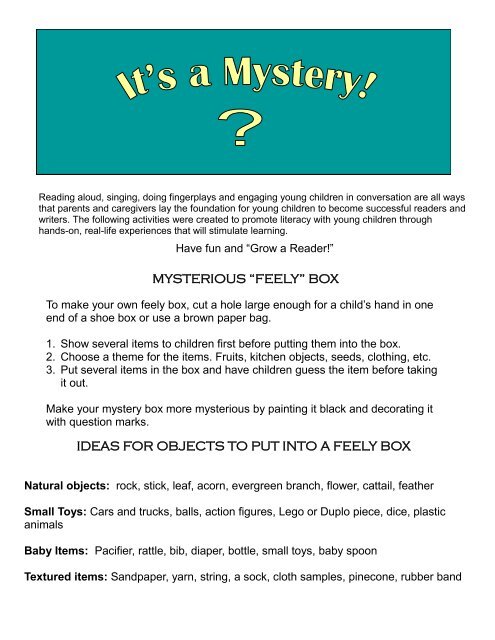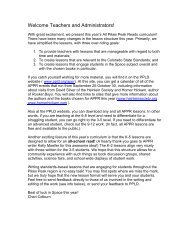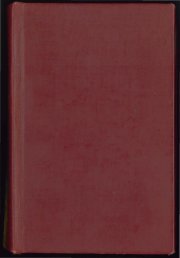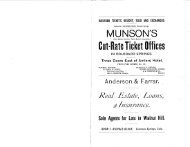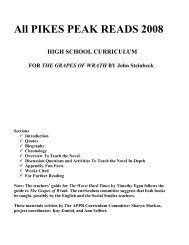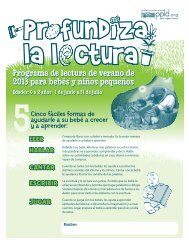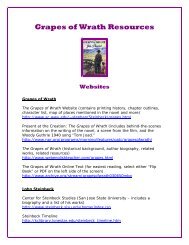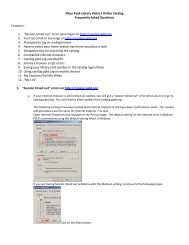MYSTERIOUS “FEELY” BOX IDEAS FOR OBJECTS TO PUT INTO A ...
MYSTERIOUS “FEELY” BOX IDEAS FOR OBJECTS TO PUT INTO A ...
MYSTERIOUS “FEELY” BOX IDEAS FOR OBJECTS TO PUT INTO A ...
You also want an ePaper? Increase the reach of your titles
YUMPU automatically turns print PDFs into web optimized ePapers that Google loves.
Reading aloud, singing, doing fingerplays and engaging young children in conversation are all ways<br />
that parents and caregivers lay the foundation for young children to become successful readers and<br />
writers. The following activities were created to promote literacy with young children through<br />
hands-on, real-life experiences that will stimulate learning.<br />
Have fun and “Grow a Reader!”<br />
<strong>MYSTERIOUS</strong> <strong>“FEELY”</strong> <strong>BOX</strong><br />
To make your own feely box, cut a hole large enough for a child’s hand in one<br />
end of a shoe box or use a brown paper bag.<br />
1. Show several items to children first before putting them into the box.<br />
2. Choose a theme for the items. Fruits, kitchen objects, seeds, clothing, etc.<br />
3. Put several items in the box and have children guess the item before taking<br />
it out.<br />
Make your mystery box more mysterious by painting it black and decorating it<br />
with question marks.<br />
<strong>IDEAS</strong> <strong>FOR</strong> <strong>OBJECTS</strong> <strong>TO</strong> <strong>PUT</strong> IN<strong>TO</strong> A FEELY <strong>BOX</strong><br />
Natural objects: rock, stick, leaf, acorn, evergreen branch, flower, cattail, feather<br />
Small Toys: Cars and trucks, balls, action figures, Lego or Duplo piece, dice, plastic<br />
animals<br />
Baby Items: Pacifier, rattle, bib, diaper, bottle, small toys, baby spoon<br />
Textured items: Sandpaper, yarn, string, a sock, cloth samples, pinecone, rubber band
MYSTERY MUFFINS*<br />
Children will love helping make these muffins, especially adding the mystery ingredients.<br />
Encourage children to try guessing the mystery ingredients when eating them too!<br />
1 cup milk<br />
¼ cup vegetable oil<br />
1 egg, slightly beaten<br />
2 cups flour<br />
¼ cup sugar<br />
1 tablespoon baking powder<br />
Butter<br />
Mystery fillings: jam, jelly, peanut butter, coconut, raisins, apple butter<br />
1. Preheat oven to 400 degrees.<br />
2. Grease 12 muffin cups.<br />
3. In a medium bowl, mix milk, oil, and egg.<br />
4. In a separate bowl, combine flour, sugar and baking powder<br />
5. Mix together wet and dry ingredients, stirring just to moisten.<br />
6. Fill each muffin cup up 1/3 full.<br />
7. Put in one teaspoon of any mystery filling.<br />
8. Add more batter to make each cup 2/3 full.<br />
9. Bake at 400 degrees for 20 minutes or until golden brown.<br />
10. For best taste, serve warm AND guess what the mystery ingredient might be!<br />
Here’s what you need:<br />
*all cooking activities require adult supervision.<br />
MAGNETS ARE <strong>MYSTERIOUS</strong><br />
Try this art activity<br />
Magnetic wands<br />
Plexiglas sheet<br />
Collection of magnetic items (for example: washers, nuts, bolts, paper clips)<br />
Tempera paint<br />
Paper<br />
Tape<br />
Thread (optional)<br />
1. Place Plexiglas across two blocks with enough room underneath to move hands.<br />
2. Tape paper to the top of Plexiglas.<br />
3. Tie varying lengths of thread to washers and nuts. (Optional)<br />
4. Dip the washers or other metal washers in paint and lay them on the paper.<br />
5. Hold the magnet against the underside of the Plexiglas and begin moving the<br />
magnet. The magnet will paint with the metal objects and thread as they move<br />
across the paper.
MORE <strong>MYSTERIOUS</strong> MAGNETS<br />
What is Magnetic? Give each child a magnet or magnetic wand. Children can<br />
stick their magnets to a variety of objects inside and outside to determine what is<br />
and isn’t magnetic. Based on their experience, ask children questions about what<br />
they think makes a material magnetic or not.<br />
Dancing String. Attach metal objects to string. Hang the string from a table or a<br />
ceiling. Can children make the strings dance with magnets?<br />
Paper Clip Mystery. Are paper clips magnetic? Stick a clip to a magnet. Ask<br />
children to predict how many paper clips the magnet will hold, Count paper clips<br />
as you add them to a chain. Do different strength magnets hold different numbers<br />
of paper clips?<br />
“WHAT’S MISSING”<br />
(a memory game)<br />
Place four or five objects such as kitchen utensils, books, small toys or items from<br />
nature on the table or floor in front of the children. Ask the children to study the<br />
objects.<br />
Cover the objects with a blanket.<br />
Use the blanket to pick up and remove one object from the set.<br />
Ask children to touch their noses when they think they know which object is<br />
missing.<br />
Once all the children have been given time to think, call on a child to reveal the<br />
missing object.<br />
Add to the number of items if children can easily guess the missing objects.<br />
SCENT DETECTIVES<br />
Challenge children to use their noses to identify mystery scents.<br />
1. Gather items that have specific, familiar scents. For example, spices<br />
(cinnamon, vanilla), foods (an orange), sauces (soy or BBQ), bath products<br />
(soaps and shampoos), or natural objects (pinecones or flowers).<br />
2. Have child close his/her eyes and try to guess the object. (A hat can be used<br />
to pull over the head to cover eyes, or hide objects by covering with a<br />
colander.
KNOCK KNOCK, WHO’S THERE?<br />
FINGERPLAY<br />
Knock, knock, who’s there?<br />
(pretend to knock, hold out hands palms<br />
up in questioning position)<br />
Two little feet that go tap, tap.<br />
(hold up fingers and tap feet)<br />
Knock knock, who’s there?<br />
Two little knees that go slap, slap.<br />
Knock, knock, who’s there?<br />
Two little hips that go wiggle, wiggle.<br />
Knock, knock, who’s there?<br />
One little tummy that goes jiggle, jiggle.<br />
Knock, knock, who’s there?<br />
Two little arms that go flap, flap.<br />
Knock, knock, who’s there?<br />
Two little hands that go clap, clap.<br />
Knock, knock, who’s there?<br />
Two Little eyes that go blink, blink.<br />
Knock, knock, who’s there?<br />
One little head that goes think, think.<br />
Knock, knock, who’s there?<br />
Open the door and see.<br />
(pretend to open door)<br />
Knock, knock, who’s there?<br />
It’s every part of me.<br />
(wiggle whole body).<br />
YOU RANG? A MUSICAL MYSTERY<br />
Items needed: a variety of musical instruments such as wrist bells, a triangle, a<br />
tambourine, rhythm sticks, maracas, sand blocks, cymbals and drum. A couch, a<br />
card table on its side or a screen made with a blanket or sheet can be used to hide<br />
the instruments.<br />
1. Talk about each instrument and the different sound it makes.<br />
2. Create a set up so that the instruments can be played without children seeing<br />
them.<br />
3. Play instruments one at a time and have children guess which instrument is<br />
making the sound.<br />
4. Let children experiment by playing each instrument.<br />
5. Play instruments and march to your favorite songs to create a musical parade.
Bring books to life with these simple ideas that highlight early literacy skills.<br />
It Looked Like Spilt Milk<br />
by Charles Shaw<br />
Presentation Notes: Could it be spilt milk or something else? Encourage<br />
children to name the shapes and join in with the story. Ask if they were<br />
surprised at the end. Go outside to look at the clouds and have children talk<br />
about what they see.<br />
Skills: Vocabulary, Narrative<br />
In the Woods: Who’s Been There?<br />
By Lindsay Barrett George<br />
Presentation Notes: Two children walk through the woods and look for<br />
clues to identify the animals who have lived or played there recently. Invite<br />
children to guess the animal and have them repeat the new vocabulary<br />
words when the answer is revealed. Follow up with a nature walk and<br />
looking for your own clues to determine who’s been there.<br />
Skills: Vocabulary, Narrative<br />
What Do You Do With a Tail Like This?<br />
By Steve Jenkins and Robin Page<br />
Presentation Notes: With its unique question and answer format, animal facts are presented<br />
with clear detail in this engaging non-fiction picture book. Encourage children to guess the<br />
animals and compare animal behaviors with what they can do with their own ears, nose, etc.<br />
Skills: Print motivation, Narrative, Vocabulary<br />
Alphabet Mystery by Audrey Wood<br />
Presentation Notes: When the letters do a roll call at the end of the day, they discover<br />
that one letter is missing! When reading aloud, make sure to pause after questions in the<br />
text to give children an opportunity to participate. Books that play with letters like this are<br />
great for developing letter recognition skills. Have children look closely at the illustrations<br />
to identify the letter who is speaking on each page.<br />
Skills: Letter Knowledge, Print Motivation
MORE GREAT BOOKS<br />
Seven Blind Mice by Ed Young<br />
Look Book by Tana Hoban<br />
Where’s Spot by Eric Hill<br />
I Spy books by Walter Wick and Jean Marzollo<br />
Who Ate All the Cookie Dough? by Karen Beaumont<br />
Other “Who’s Been There” titles by Lindsay Barrett George:<br />
In the Snow, In the Garden, Around the World


